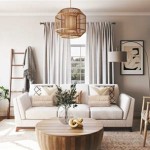Living Room Interior Colour Schemes
The living room is a central hub of any home, a space where families gather, guests are entertained, and memories are made. The colour scheme you choose for this room can profoundly impact its ambiance and functionality. Here's a comprehensive guide to help you select the perfect living room interior colour scheme for your needs and preferences.
Neutral Colour Schemes
Neutral colour schemes form the foundation of many living rooms. They offer versatility, timelessness, and a blank canvas for adding pops of colour through accessories and furniture. Popular neutral hues include beige, cream, white, gray, and black. These colours provide a neutral backdrop that complements any décor style, from traditional to modern.
Monochromatic Colour Schemes
Monochromatic colour schemes revolve around variations of a single hue. This approach creates a cohesive and sophisticated look, allowing you to play with different shades, tones, and textures of the same colour. For example, a living room decorated in shades of blue could range from pale aqua to deep navy, offering a sense of depth and visual interest.
Analogous Colour Schemes
Analogous colour schemes utilize colours adjacent to each other on the colour wheel. This creates a harmonious and visually pleasing effect, as the colours share common undertones. For instance, an analogous scheme could include shades of blue, green, and yellow, or red, orange, and yellow. These schemes create a sense of balance and flow.
Complementary Colour Schemes
Complementary colour schemes feature colours directly opposite each other on the colour wheel. This pairing creates a high-contrast, eye-catching look that is both vibrant and stimulating. For example, a living room adorned in shades of blue and orange, or green and red, will exude a sense of energy and drama.
Triadic Colour Schemes
Triadic colour schemes utilize three colours equally spaced around the colour wheel. This approach creates a highly dynamic and visually striking effect. To achieve a triadic scheme, choose colours that are 120° apart, such as red, blue, and yellow, or purple, green, and orange.
Split-Complementary Colour Schemes
Split-complementary colour schemes are a variation of complementary schemes. Instead of using the direct complement, this approach employs the two colours adjacent to the complement. For example, a split-complementary scheme could include a primary colour, such as blue, and the two colours on either side of its complement, such as yellow-orange and red-orange.
Consider the Room's Function
Before choosing a colour scheme, consider the primary function of your living room. If the space is used for relaxation and entertaining, opt for calming colours like blue, green, or lavender. For a more formal living room, neutral hues or rich, saturated colours like navy, emerald, or burgundy create a sophisticated ambiance. If the room receives ample natural light, you can experiment with bolder colours, while darker spaces may benefit from lighter, brighter hues.
Consider the Furniture and Décor
The existing furniture and décor in your living room can influence your colour scheme. If you have pieces with bold patterns or colours, opt for a more neutral colour scheme to avoid overwhelming the space. Conversely, if your furniture is simple and understated, you can introduce more vibrant colours through the walls or accessories.
Don't Forget the Lighting
Lighting plays a crucial role in the overall ambiance of your living room. Natural light can alter the appearance of colours, so consider how the room is oriented and the amount of natural light it receives. Artificial lighting can also impact colour perception, so experiment with different types of bulbs and fixtures to find the combination that best complements your chosen scheme.
Experiment with Samples
Before committing to a colour scheme, it's essential to experiment with samples. Paint a small section of the wall in your desired colour and observe how it looks at different times of day and under different lighting conditions. You can also bring home fabric swatches or wallpaper samples to see how they coordinate with your furniture and décor.
Seek Professional Advice
If you're struggling to choose a colour scheme or need guidance in creating a cohesive design, consider consulting an interior designer. A professional can provide expert advice, help you navigate colour theory, and ensure your living room reflects your unique style and needs.

15 Best Living Room Color Schemes Designers Swear By Decorilla Online Interior Design

Colour Combination And Schemes For Living Room In 2024

30 Best Living Room Color Schemes Stag Manor

55 Best Living Room Color Ideas According To Design Experts

11 Cozy Living Room Color Schemes To Make Harmony In Your

50 Best Living Room Paint Ideas Colors

30 Best Living Room Color Ideas Schemes Decoholic

The 65 Best Living Room Paint Colors To Complement Any Aesthetic

Living Room Colour Schemes Best Palettes Home Inspiration Ideas

How Do You Choose A Color Scheme For Living Room Designers Share Their Secrets Put Together Look Livingetc








